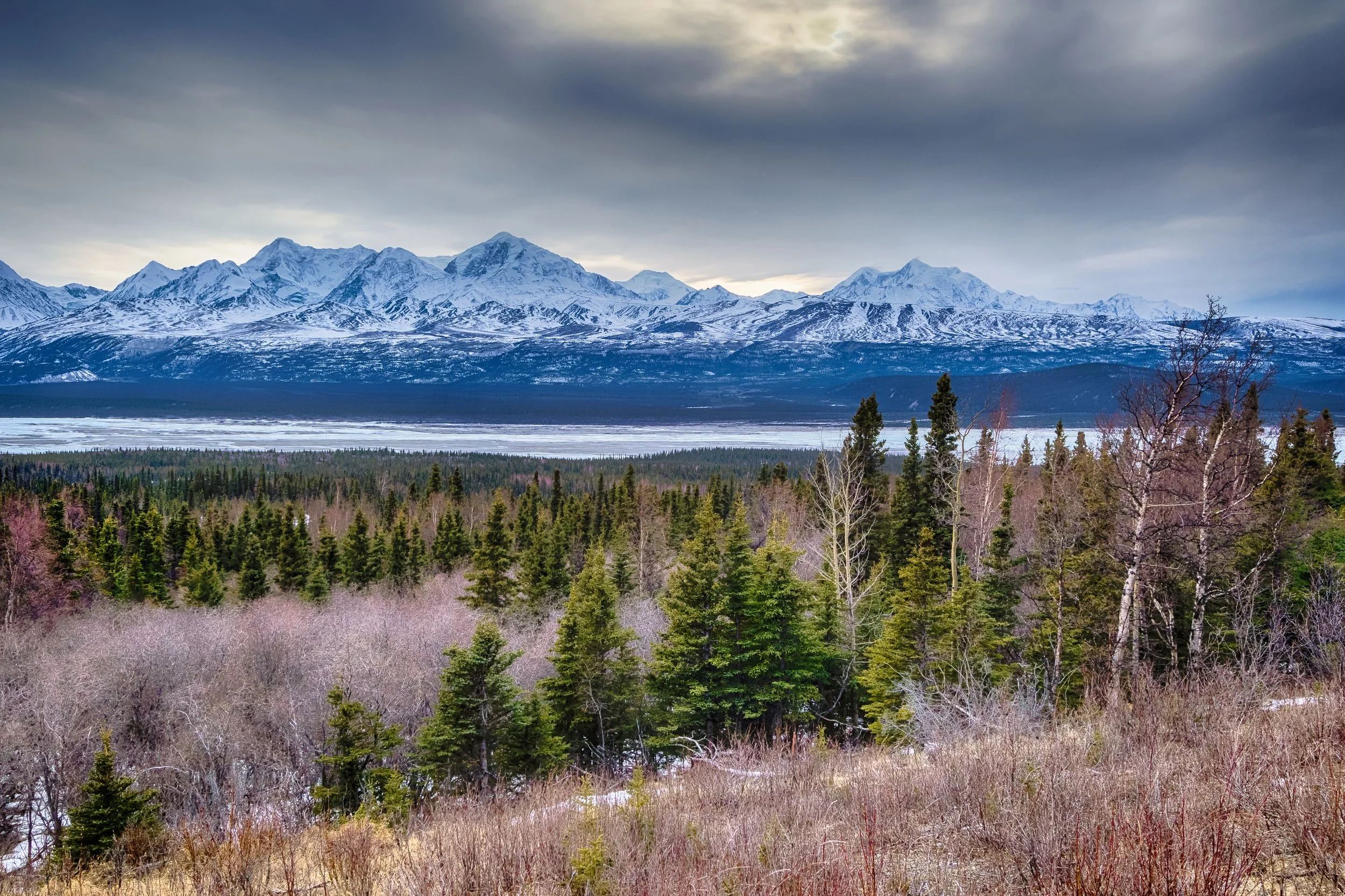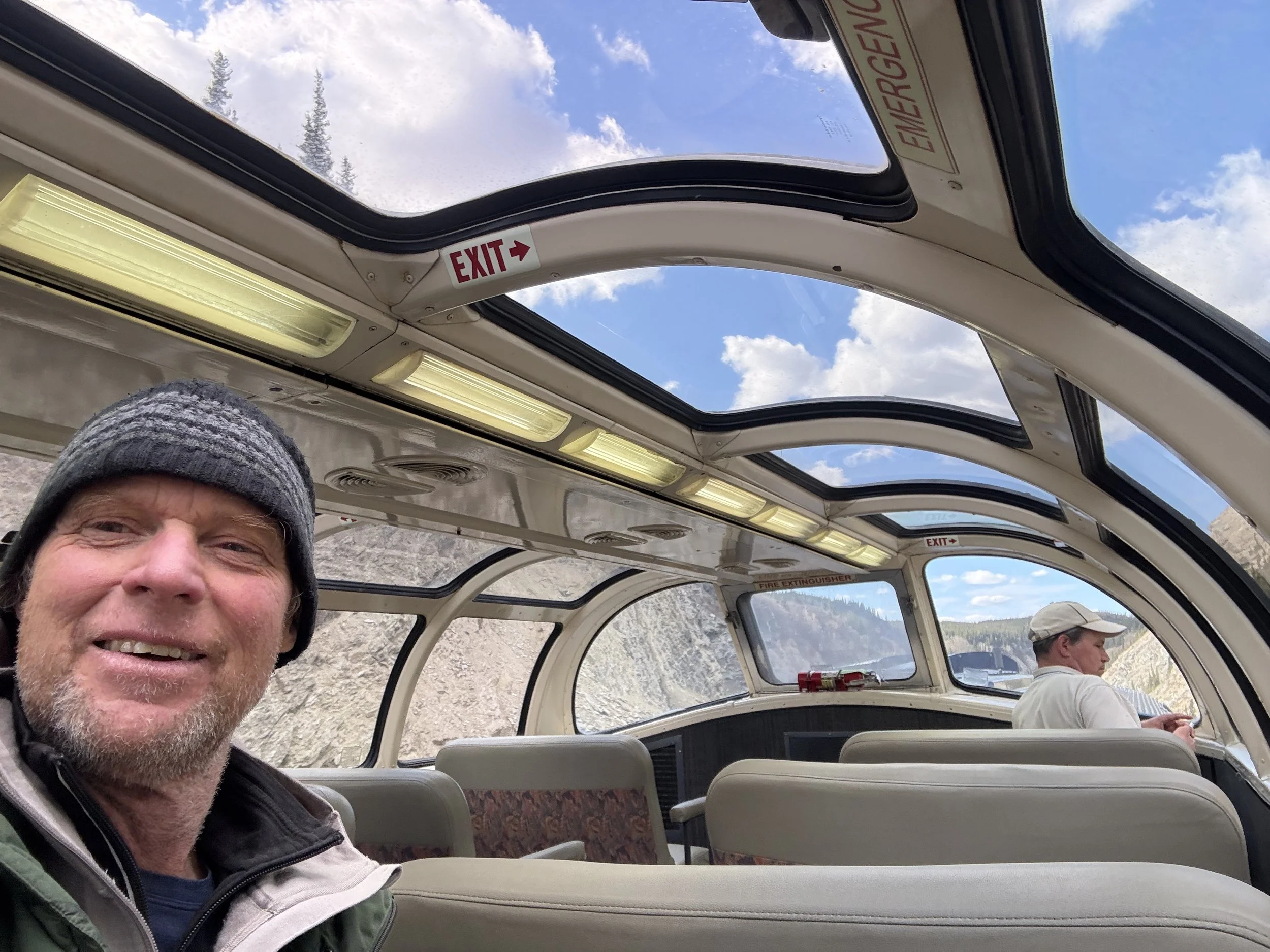The Quiet Stories That Land Can Tell
By Joe Tedino
Photo by Eric Larson.
Rob Mahedy, a 59-year-old cancer survivor from Crested Butte, Colorado, arrived in Alaska this spring with a purpose: to summit Mt. Hayes via the Washburn route. No stranger to high-altitude climbs—he’s soloed Mt. Earnslaw in New Zealand, Island Peak in Nepal, and Denali (Mt. McKinley)—Mahedy encountered a different kind of challenge this time. In Fairbanks, he heard reports of a milder winter and below-average snowpack, signs of a shifting climate he could not ignore. He adjusted course, choosing not to summit this year but to climb as far as the famed knife ridge, saving the final push for another expedition. As with his own survival, the lesson was clear: adaptation is not a sign of weakness—it’s wisdom.
“I didn’t get to the top,” Mahedy said in an interview shortly after his eight days on Mt. Hayes, “but I do consider it a successful reconnaissance climb.”
First climbed in 1941 with low-tech gear and legendary grit, the Washburn route to the Mt. Hayes summit is still considered one of Alaska’s great mountaineering achievements. Known formally as the North Ridge, the route’s reputation rests not only on its technical difficulty, but on the boldness of those who first dared to climb it. Towering 13,832 feet and rising more than 8,000 feet from the valley floor in just over two miles, Hayes is the tallest peak in the eastern Alaska Range—and one of the steepest in the country. So formidable is its Northeast Face that it wasn’t summited again until 1975, when climbers Charles R. Wilson and Steve Hackett led a four-person team across the ridge. In the American Alpine Journal that year, Wilson recalled sections so narrow and soft that “you could not put your feet side by side”—a place where progress toggled between precision and peril.
Mahedy remembers a previous climb that took him to the top of Denali—the classic West Buttress, a route that was also pioneered by Bradford Washburn. Climbing with a small group at first, he broke off and made his way up during a 21-day adventure. “I stood atop the summit alone,” he recalled. “I had a clear summit day and could see down the Susitna River to Cook Inlet and west to the Bering Sea.” He descended for six days on skis. With Hayes, he was searching for a similar moment of stillness.
To begin his Mt. Hayes climb along the Washburn route, Mahedy flew to Anchorage and then boarded the Alaska Railroad for the 12-hour trip to Fairbanks, where his local fact-finding began. A number of questions ran through Mahedy’s mind as he met up with experienced climbers in Fairbanks. “What am I up for, what am I getting myself into?” he wondered. “These people have local knowledge, so what went through my mind was, ‘What can I learn?’ ”
Mahedy was confident about withstanding the bitter cold temperatures, which can drop below −4°F with windchill factors below −22°F. Even with his experience in Alaska and Nepal, he knew to be wary of the glacier travel and potential crevasse navigation ahead of him. Weighing heavier on Mahedy was how cancer would affect his strength and stamina.
Mahedy, a muscular six-foot-four alpinist, left New Jersey for Crested Butte as a young man and quickly took to the mountains like a local. He hiked, skied, cycled, and climbed with the quiet intensity of someone who doesn’t just visit wild places but needs them and absorbs the solitude. A carpenter by trade, he’s helped restore many of the historical commercial buildings in Crested Butte’s bucolic downtown, shaping the town with the same hands that have gripped ice tools on Himalayan ridges.
But his passion lies beyond the summits—deep in the hidden recesses of the backcountry. “I seek out remote mountain ranges that are not heavily visited,” he said. “I follow bighorn, mountain goats, elk, caribou—sometimes bear and wolverine—looking for freshwater springs, and often I’ll stumble on evidence of the people who were here before us.” For Mahedy, wilderness exploration isn’t just about elevation—it’s about connection, and the quiet stories the land can tell. Whether it’s a summit or a century ride, Mahedy tends to meet the landscape on its own terms—and rarely turns back.
But his battle with aggressive bladder cancer and lung cancer since the middle of 2024 has taken its toll on his health and fitness. Last November, a tumor was removed from his abdomen along with his bladder. Doctors fashioned a replacement neobladder using material from his small intestine. Then his cancer—urothelial cell carcinoma—was found to have metastasized in his lungs, requiring weeks of chemotherapy.
Mahedy had an abnormal winter as he underwent treatment—only a few outdoor adventures close to home, including a weekend camping trip in March that enabled him to experiment with how to empty his neobladder in cold temperatures. Climbing Mt. Hayes along the Washburn route was a goal he set for himself last year, as long as his body would survive.
On May 8, after receiving good news from his doctor that immunotherapy treatments had shrunk the tumors on his lungs, Mahedy set out for Fairbanks. There, he met local Mike Hopper, who told Mahedy that he had attempted Hayes five times himself. During a 90-minute meeting over coffee with Hopper, Mahedy spread out his maps on the table and described his plan. Hopper pointed out the best routes to take and the ones to stay away from. Later, at an equipment store, Mahedy met Grant Wilson, a local climber who has explored around Mt. Hayes many times as well. He and Mahedy discussed climbing together next April when the temperatures are likely to be colder and the snow conditions more favorable for a summit attempt. Wilson explained that the lack of snow, warmer May temperatures, and the fact that Mahedy was going it alone made reaching the summit this time unpredictable.
Rob Mahedy documents his solo spring expedition to Alaska’s Mt. Hayes—a journey of resilience, reconnection, and reconnaissance. From trains and bush planes to whiteouts and ridgelines, each snapshot marks a step in his ongoing quest to meet the wilderness, and his own limits, on their own terms.
Mahedy assembled supplies for a 14-day mountain exploration, then met pilot Jesse Cummings at Golden Eagle Outfitters. They planned a 45-minute flight into the wilderness, but trouble arose immediately. Due to a winter with low snowfall, their aircraft’s skis couldn’t land at the intended drop-off point. They had to return to Delta Junction, transfer Mahedy’s gear to another plane equipped with low-pressure tundra tires, and then fly back to the Stonehouse drop-off.
With little snow, Mahedy had to haul his 60-pound supply sled over bare ground, which required offloading some equipment and making multiple trips to a camping spot. “Every mile turned out to be three miles—up and back and up again,” he said. Eventually, he made his way up to “this beautiful lateral moraine on this massive Hayes glacier. I finally got to the snow.”
Carrying 50 pounds on his back and pulling the sled, Mahedy spent three days getting to an elevation of 6,000 feet, which revealed a stark truth: His strength had deteriorated significantly. His decline was a direct result of inactivity over the previous six months following surgeries and chemotherapy. Despite his attempts at prior conditioning—limited backcountry skiing and mountain climbing in March and April before his Alaskan venture—he had lost ten pounds and considerable muscle mass.
“My fitness was not as good as it could have been,” he said. “But I could feel myself getting stronger as I went up—my legs, my thighs, my back. So that was encouraging. I was certainly physically weaker than I’ve been in over a decade, but I felt I was mentally stronger than ever to climb and climb safely.”
But cancer had not only taken a toll on his muscles and fitness. There were now new logistical challenges to contend with as he learned to navigate utilizing his replacement neobladder. On Mt. Hayes, Mahedy carried a lightweight cot that enabled him to recline above the ground and, when necessary, to use gravity to help the flow of urine into a urostomy bag. “I had to catheterize myself, and I figured all that out; nothing froze,” he said with a laugh. In this way, Mahedy locked down some survival beta that most alpinists never think twice about.
Over the course of his days on the mountain, two whiteout snowstorms dumped a foot of snow on the glacier, adding more uncertainty to his quest. During those hours, he read and enjoyed the sounds and sights of the wilderness. It also gave him a chance to reflect on why he does these climbs. “It’s a quest for me to find happiness,” he said. “I find joy in deep wilderness, where there is solitude, and it’s just me, the elements, and the animals in nature. I really do enjoy being high up in the mountains by myself.”
Once the snow let up, he was able to continue to an elevation of about 9,000 feet where he got a full view of the route that goes up the knife ridge to the summit. “It was very valuable to have two days of clear weather to get up on the ridge high above the glacier and see the original Washburn route,” Mahedy said. “I give them a lot of credit for doing what they did back in the 1940s.”
Mahedy feels good about his Mt. Hayes trial run and has made plans to climb with Wilson, the Fairbanks climber, next April to finish the job. “He and I will get together, perhaps with another guide or two—we’ll try to keep it a small group—and go for the full summit push,” Mahedy said.
The plan fits Mahedy’s new mindset since his cancer diagnosis. “I know I need to rely more on others and to not go it alone,” he said. As a cancer patient, Mahedy experienced an outpouring of support from family and friends, as well as from two local cancer support organizations—Gunnison Tough and Living Journeys. Both have been at his side since his diagnosis in May 2024.
“When I tell my doctors about the help that I’m getting, they are pretty amazed,” he said. “Our small community is really helping me financially, mentally, and nutritionally. I think the love is as important as the medicine.”














